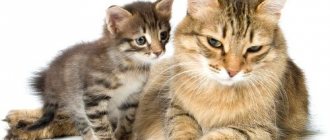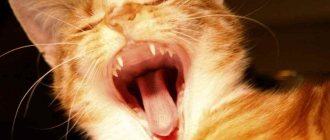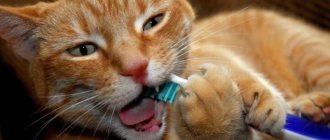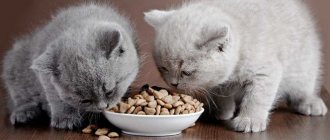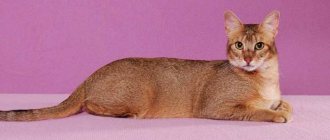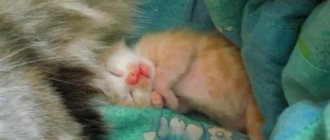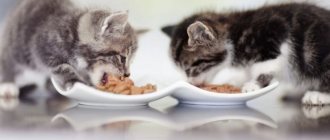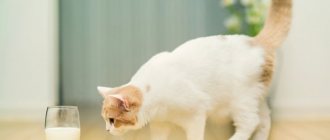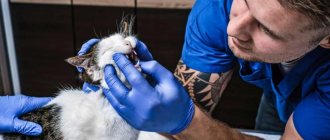Hello, dear blog readers!
If you are just getting ready to become the owner of a little furry friend, or you suddenly have a newborn baby, then this article will come in handy.
After all, taking care of the little ones is a pleasant chore and, at the same time, very responsible. The most troubling thoughts are: how to properly feed a fluffy? Especially if he is only a few days old, or maybe even hours old.
Of course, mother’s milk for babies is the key to proper development and good health; it is indispensable for the formation of strong immunity. And if there is no or little of it, is baby formula suitable for a kitten? In this case, it is necessary not only to feed, but also not to harm the cub.
Regime and rules for feeding newborn kittens
Newborn kittens need to be fed as often as possible - this is an axiom. It is natural for them to eat often, but little by little. Unfortunately, one person simply cannot provide orphans with round-the-clock access to a bottle.
How often should kittens be fed depending on age:
A newborn kitten sucks until it is satisfied, and then falls asleep again. Feeding itself does not take much time, usually no more than 5 minutes.
Kittens eat often, but little by little
1 week – every 2 hours, including at night. More often if the kittens wake up and squeak (sometimes you have to feed them every hour).
Week 2 – every 3 hours, at night every 4 hours.
Week 3 – feeding every 3-5 hours, at night the interval can be 6 hours if the kittens do not wake up.
4th week – kittens are fed on average 4-6 times a day (every 4-6 hours), by the end of the week they begin to introduce complementary foods.
Month-old kittens begin to eat special canned food
How to prepare the mixture
If you are using a commercial milk replacer, detailed instructions will be provided on the packaging. The general principle is this: boil water and let it cool to about 50°C. Pour the mixture powder into the water, stirring constantly so that there are no lumps. The prepared solution is poured into bottles. When the milk has cooled to 35-36oC, it is given to kittens.
It is not recommended to store the finished mixture. But this is perfectly acceptable if you keep it in the refrigerator. A pre-prepared solution at night is especially helpful. Then you only need to heat the milk to the desired temperature - in the microwave or in a water bath.
How to feed a newborn kitten
Ideally, the kitten is fed from a special bottle with a nipple, and the diameter of the nipple hole varies depending on the age of the baby. In real life, buying such a bottle can be a problem. An alternative would be a plastic syringe without a needle.
The kitten is fed by holding it upright if it is very small, or lying on its stomach. It is strictly forbidden to place the kitten on its back. Kittens must suck the bottle or syringe nozzle themselves; pouring the mixture into them is unacceptable - it can get into the respiratory tract.
Kitten drinks from a bottle
Many newborn kittens die from aspiration pneumonia caused by improper feeding, and not at all from a draft or viral infection. No force feeding.
The bottle is held at an angle of 45°C, it should be comfortable for the kitten to suck. The muzzle will be raised up.
The correct position of the bottle is at an angle of 45 degrees
How much milk to give a kitten at one time
The amount of formula fed to a kitten depends on the age and weight of the baby. Kittens are usually fed ad libitum so that the sleepy baby falls off the nipple on its own. But sometimes overfeeding leads to digestive problems, and you need to at least approximately adhere to the standards indicated on the packaging of the cat's milk replacer.
In the first week the kitten will drink about 2-5 ml at a time, in the second week 5-10 ml, then 10-15 ml.
Cow's milk or baby formula is too watery for kittens. Their kitten will drink more, stretching its stomach and suffering from colic. Cat milk replacer is high in protein and fat. It is more concentrated, more nutritious. And you only need a little bit of it in terms of volume.
Kittens are not given water until they begin to lap from the bowl on their own.
Tummy massage
After each feeding, the kitten is helped to relieve itself. To do this, carefully massage the tummy clockwise. In addition, you need to massage the anus with a damp cotton pad or napkin, imitating the movements of a cat's tongue.
Urination should occur after each meal, and bowel movements on average 4 times a day. The stool should be light brown and soft. Kittens will only have formed stools when they start complementary feeding. The butt is wiped first with a damp and then with a dry cloth.
Kittens must poop from the first day of birth. If there are no stools, a veterinarian's examination is necessary. The kitten may have congenital underdevelopment or occlusion of the anus and other problems.
The kitten needs not only to be fed, but also to be helped to defecate.
Weighing
To make sure that kittens are digesting food and growing, they need to be weighed. In the first week it is better to do this daily. The weight gain should be about 15 grams. You can weigh babies using electronic baby scales or kitchen scales. If the scales are not equipped with a bowl, the kitten is placed in a container.
This kitten's eyes haven't opened yet. Weighing on a kitchen scale
This kitten weighs almost 700g and can eat dry kitten food
Hygiene procedures
In addition to nutrition, you should know other rules for caring for a newborn kitten. After eating, you can massage your cat's tummy clockwise with your fingers or the area under the tail, using a cotton pad soaked in water to empty the intestines.
Cats lick their cubs and try to keep their mouths, eyes, ears, and excretory organs clean. Wipe and wash the cat with warm and damp wipes, dry it so that it does not freeze after the procedures. Wash completely once a day in warm water.
The kitten needs a place to sleep and play at first. To begin with, a deep box is suitable, in which you need to lay soft bedding.
Cover your cat's area with old diapers or cut-up sheets so they can be easily washed or thrown away.
Can it be given to kittens?
What products can be used to feed kittens if the owner prefers natural feeding for his cat?
Many foods that are acceptable in the diet of an adult animal are not recommended for kittens. This is explained by the fact that some foods are heavy for a fragile digestive system or carry a large amount of energy without satisfying the basic needs of a growing body.
The kitten’s diet should include foods that are as healthy as possible; they should be well digestible and not contain harmful substances.
Is it possible to give kittens milk?
The question implies: is it possible to give kittens what is familiar to us and most used by humans - cow's milk?
Cow's milk is not the best choice for feeding an early kitten. The composition of the milk of each species of animal is ideal for feeding its own young, but not suitable for the young of another species.
The composition and ratio of fats, carbohydrates, proteins and other chemical elements of cat and cow milk are different from each other. Cat's milk contains half the fat and 2.5 times more protein than cow's milk. It also differs in the ratio of proteins and the content of other, organic and inorganic chemical elements per unit volume.
Milk can be used in small quantities for feeding older kittens and feeding adult cats, as long as it does not cause digestive upset in the pet.
For small kittens from birth to 1 month, artificial cat milk is ideal; it can be purchased at pet stores.
Baby food (formula)
Can be used for artificial feeding of a newborn and feeding older kittens. When feeding with formulas, their concentration should be 2 times less than for children in the first week of life.
Dairy products:
Cottage cheese, sour cream, kefir, fermented baked milk, and cream are used to feed kittens in addition to meat, as a source of protein and calcium. Fermented milk products also improve the composition of microflora. You need to choose dairy products with minimal fat content.
Raw meat
It is not advisable to feed minced fish to kittens; before feeding, the fish must be boiled, and the meat either frozen or scalded.
Meat products form the basis of a kitten’s diet; preference should be given to veal, beef and chicken. You can feed lamb, rabbit meat, horse meat. It is not advisable to feed pork - it is too fatty.
Veal and beef can be used for feeding daily, choosing pieces without fatty inclusions. Give in the form of minced meat or scraps (from the beginning of complementary feeding to 7 weeks) and in the form of small pieces, no more than 1 cm, for older kittens.
If the meat is fresh, you can serve it raw, without any processing, or scald it with boiling water first.
It is better to give chicken meat boiled; raw meat may contain the causative agent of salmonellosis. You can feed it every other day.
Fish is given up to 2 times a week.
Liver
A valuable by-product, it is rich in B vitamins and iron. The liver contains a large amount of vitamin A. Kittens are given beef or chicken liver 2 times a month. In addition to the liver, it is also useful to feed other offal products - heart, kidneys, lungs. They are used more often - 2-3 times a week. Cats should not be fed spleen.
Cereals
Rice, oatmeal, semolina are used in the form of liquid porridges in milk without sugar (up to 3 months of age) or boiled in water, mixed with fish or meat: cereal - 1 part, meat - 2 parts.
Vegetables
They must be present in the diet in boiled or raw, pureed form. They are added to porridges, given mixed with yolk, meat or fish, several times a week.
Dry food
If you are an adherent of artificial nutrition, choose high-quality food for your kitten; experts do not recommend feeding kittens with food of classes lower than premium or super-premium. Start with food soaked in water. Monitor your kitten's water consumption - it should be of good quality and always available. Use dry food, alternating it with wet food from the same manufacturer, the ratio in the diet is 70% dry, 30% wet.
Food for adult cats should never be given to a kitten. Excessive doses of vitamins, macro- and microelements can lead to many negative consequences, from diseases of internal organs to poisoning with biologically active substances, which include vitamins.
Recipes for making your own mixture
If the kitten tolerates pasteurized cow's milk well, then you can make him dishes based on it. To prepare the classic recipe you will need:
- a glass of warm milk;
- 2 chicken egg yolks;
- vegetable oil - 1 teaspoon;
- 1 drop of multivitamin solution (for example, Trivita or Tetravita).
If the kitten is very weak and thin, you can prepare a sweet mixture based on condensed milk - it contains enough fats and carbohydrates so that the baby quickly gains weight and gets stronger. It is made according to the following recipe:
- Condensed milk is mixed with water in a ratio of 1:5.
- Add bone meal at the rate of 1 teaspoon per liter of liquid.
This dish is only allowed to be given to kittens over 1 week old. Suitable only for emergency feeding (after 5–7 days you should switch to a regular formula with milk or a powder substitute).
Why do experts recommend “dilute” your diet?
On almost all packages of quality food you will see recommendations regarding two types of feeding. The daily rate of dry food if it is not diluted with anything and the daily rate if dry food is diluted with wet food. What is the reason for this duality and why, in recent years, have veterinarians insisted on mixing wet and dry food?
Consequences of feeding only dry food
Dry food is produced in several stages. The products are crushed and dried. During the manufacturing process of food, its food base goes through several stages of heat treatment.
The granules themselves are formed from several types of powder: protein, carbohydrate, fat, mineral and vitamin components. To shape the granules, the mixed powder is slightly wetted, pressed and dried again. At the last stage, preservatives are added to the feed, which allow the granules to be stored in closed packaging for up to 3 years and unopened for up to six months.
After swallowing the granules, the cat feels very thirsty as the food begins to absorb gastric juice. In order for the granules to descend into the intestines, they must be saturated with moisture, become soft and more voluminous.
It is for this reason that when a cat eats the prescribed portion of dry food, it still asks for more for some time. The pet feels that the stomach is not full until the granules swell.
Before swallowing, an adult cat chews the granules into two parts. If you look closely at the process of food absorption, it will become noticeable that the incisors are practically not involved in chewing. Since kittens' chewing teeth are poorly developed, they have two alternatives: swallowing the pellets whole or chewing them with their front teeth.
Note that small kittens rarely control their feeling of fullness, which often leads to overeating. Regular, excessive intake of dry foods can lead to physical stretching of the stomach walls, leading to the problem of overeating on an ongoing basis.
Is it possible to feed a kitten only wet food?
Let us remind you that until six months of age, kittens should receive exclusively soft food. If you choose the industrial type of feeding, then the kitten must be fed wet or semi-moist food. When the baby turns 6 months or more, you need to think about adjusting the diet.
Constant consumption of exclusively soft food leads to reduced stress on the cat's gums. When a pet experiences hard food, its gums become stronger, which ensures a normal process of tissue renewal. If the chewing load is insufficient, the gums become loose and the teeth quickly deteriorate.
excellent food for cats that are fed natural food and those that are recovering from illness (+ photo)
Until recently, I didn’t know that cats simply adore “Tema” meat and vegetable puree. In fact, they are intended for feeding children from 8 months. But I have cats (two) who eat exclusively natural food (chicken, beef, turkey) and there’s a lot of fuss with preparing their food separately. but there are also fewer health problems than those who eat industrial feed.
So, after an illness, I had a weakened cat (one year old). She is not good at eating meat, because she quickly gets tired of chewing it, and I don’t always have time to process meat into minced meat.
While I was treating her, I studied information about nutrition on the forums of cat breeders and discovered that those who feed animals with natural food use baby food such as “Tema”, “Babushkino Lukoshko”, “Gerber” and others in their diet (it’s only important that there are no potatoes, no pork and no fish. Important
Make sure that the composition does not contain onions, garlic, or soy protein).
I decided to try it. I bought “Tyoma” puree with beef and buckwheat. It turned out to be excellent food for a cat. It bursts so you can't tear it off. Since it is puree and not a piece of meat, there is no need to chew it, and she does not get tired. Easily digested. Dietary (relatively of course). He goes to the toilet perfectly - without diarrhea, but also without constipation. I just started to recover at a rapid pace (pah-pah). He has a voracious appetite - he eats 2 jars a day and quickly regains the weight lost during illness. She eats it so much that she doesn’t have to persuade her (it’s apparently still hard for her to digest meat after her illness). One jar contains 100 grams of the finished product.
And what I like most is that usually I can’t force cats to eat, in addition to meat, vegetables and porridge (cereals - buckwheat, rice, etc.) and in the form of puree they crack “with a bang”
This is important because they also need carbohydrates, not just proteins. especially if the animal’s kidneys are weak or diseased, then they need less protein
The main thing is that it contains no lactose, preservatives, GMOs, flavors or dyes. and other rubbish. The composition is as follows: beef; buckwheat; sunflower oil, potato starch, table salt (but I tried the taste - the canned food is completely bland, there is very little salt in my opinion. Just what is needed for cats); dill extract, water. I think it’s a good composition! However, there is one small inconvenience: after opening the can, the product’s shelf life = 1 day. After this it cannot be used. Mine are great at persuading a whole jar in a day and more than one. So there is no problem with this. The manufacturer also recommends warming it up slightly. There is a catch here: if you reheat a portion and she doesn’t eat it all at once, then reheating is prohibited - all that’s left to do is throw it away if she doesn’t eat it.
I can tell you from my own experience - I DO NOT reheat it, it already smells like meat. I leave the jar to sit at room temperature (although these canned foods do not require a refrigerator) and serve it that way. They eat great. After heating in the microwave, these canned foods simply become more flavorful. This does not affect my cats in any way, since they eat it just fine without heating.
I highly recommend it to those who have cats on natural food and to those who are recovering from an illness.
Review of brands and price
Of the existing brands of milk replacers for kittens, veterinarians highlight Royal Canin, GimCat and Beaphar, calling their products the highest quality and balanced in composition.
Royal Canin
Royal Canin
Royal Canin Babycat milk is a complete cat's milk substitute for kittens from birth to two months of age. This product is an ideal replacement for cat milk.
In terms of the percentage of lactose, this substitute is as close as possible to natural milk. In addition, the food contains a sufficient amount of easily digestible proteins, ensuring active development of the kitten in the first months of life.
According to consumer reviews, when feeding this product, kittens quickly gain weight (up to 10 g per day) and height. The protein and fat content of Babycat milk is very high (33 and 39%, respectively). The food contains all the ingredients necessary for kittens (amino acids, fatty acids, prebiotics), as well as a rich complex of vitamins and microelements.
In addition, the food contains docosahexaenoic acid (DHA). This is an important ingredient in cat milk, necessary to stimulate the brain activity of babies. Babycat milk milk replacer does not contain a starchy component that is harmful to the body of kittens.
Beaphar Kitty Milk (Beafar)
Beaphar Kitty Milk, a cat's milk replacer produced in the Netherlands, is suitable for feeding kittens of any breed from birth until they reach the age of 35 days. In terms of the amount of proteins and fats, Kitty Milk is as close as possible to cat milk. Contains all the ingredients your pet needs for full development.
In addition to the main nutrients (proteins, lipids, lactose), the food is enriched with useful substances: unsaturated fatty acids, taurine, vitamin complex (A, C, D, group B), microelements (iron, zinc, calcium, phosphorus, manganese, copper) . The product can be used to restore the health of adult animals, as well as for pregnant cats that need stimulation of the lactation function of the mammary glands.
GimCat Cat-Milk (Gimcat)
GimCat Cat-Milk contains all the necessary nutrients in the right proportions to ensure ideal development for kittens. Thanks to the amino acid taurine, Cat-Milk helps lay the foundations for good vision, strong digestive and cardiovascular systems.
GimCat Cat-Milk
Arachidonic acid provides a beautiful coat. The main component of the food, meat protein, is highly nutritious and is easily absorbed by the baby’s body.
Galactopolysaccharides (a type of ballast substances) help form the intestinal microflora.
Thanks to its balanced composition, GimCat Cat-Milk can be used as additional nutrition for pregnant cats, for adult and elderly pets (during the recovery period), as well as for supplementary feeding of kittens after transition to solid food.
Trovet Kitten Milk KMS
Trovet Kitten Milk KMS
Trovet Kitten Milk KMS is a milk replacer for kittens based on high-quality and easily digestible protein. Trovet Kitten Milk KMS provides babies with adequate nutrition and activity throughout the day.
Due to the moderate amount of lactose, the product is suitable for feeding puppies. In addition, this food can be used as a supplementary nutrition for cats bearing kittens and for lactating cats.
The milk has a high taste and is liked by kittens. The food contains valuable microelements (potassium phosphorus, sodium, zinc, iron, magnesium, manganese) and vitamins (A, D, E) necessary for the development of a small organism.
Kittenmilch CDVet
Kittenmilch CdVet (Kittenmilk)
Kittenmilch CdVet is a milk replacer made from whole milk powder with the addition of colostrum.
Kittenmilch CdVet is a natural product with a high content of quality proteins and fats, providing high nutritional value. The presence of colostrum makes the substitute an ideal food for kittens.
The manufacturer recommends using the substitute as the main food or as supplementary feeding in case of hypogalactia in the mother cat. It contains substances that strengthen the digestive and immune systems of kittens.
Advice! Immediately after feeding, it is recommended to stimulate the baby's digestion by lightly stroking the tummy in a circular motion.
Baby food
Formula milk for newborn babies is as close in composition as possible to a woman's breast milk. They are mainly made from cow's milk. To ensure that the child’s body easily absorbs nutrition, milk protein is changed and dry formulas with different degrees of preparedness are obtained:
- adapted. The most complete nutrition for babies is used from birth to 6 months;
- partially adapted.
Properties similar to breast milk, but do not contain minerals and essential fats, are suitable for children after 6 months; - low-adapted.
The composition is obtained from whole cow's milk with the addition of sucrose and starch. Give to babies after one year.
Infant formulas made with goat's milk have also recently appeared on the domestic market. This option is good for newborns who are allergic to cow products.
Question
: from birth to one year, the choice of options for infants is large, but what to choose for mustachioed suckers?
What to feed a kitten?
Just a great option is to try to find a nursing cat that would accept other people’s kittens and start feeding them. But such an opportunity is not always available.
So, there is no mother cat, and we feed the kittens ourselves
.
First, you need to find a replacement for cat milk. The milk of each animal is ideal for feeding only its young, and other milk cannot be a complete replacement. A good option is to buy a cat milk replacer at a pet store.
also
prepare a milk formula
, which will be approximately equal in nutritional value to a cat's milk. Precisely in terms of nutritional value, and not in terms of other indicators. The fact is that the protein content in cat's milk is 10 times higher than in cow's milk.
To prepare this cat mixture, you need to mix 4 parts of boiled
milk (cow's or goat's) with 1 part egg white and beat until smooth.
If the kitten does not tolerate cow's milk well, you can use dry formula for infants
. Such mixtures must be prepared according to the instructions, but diluted twice as thin as required for feeding a 1-2 week old baby.
What food and how much to give to a kitten - Feeding schedule
Every day the kitten gains about 20 grams. For every gram added in weight, the amount of mixture increases by 4-5 grams.
Kittens that are fed by their mother but are underweight can be fed baby formula or porridge.
Don't forget to make sure all the kittens are well-fed. If after feeding all the kittens sleep, this means that they all got milk. And if they squeak and crawl and suck a finger extended to their mouth, they are starving. Try to place such kittens directly to the cat’s belly.
As mentioned above, kittens from 3 weeks should begin to be fed additionally, including those fed by their mother.
At 3-4 weeks of life, the kitten’s diet should be diversified
food rich in animal and milk proteins: 1) skipped (finely chopped) lean beef, fish (along with porridge); 2) baby meat food (in jars); 3) low-fat cottage cheese, egg yolk.
When giving such food, it is necessary to monitor the kittens' stool - if the stool is loose, it is better to dilute the milk with water to reduce the amount of lactic acids in the mixture.
After 4 weeks of life, you can begin to accustom kittens to a bowl.
First, lubricate (wet) the kitten's mouth with the milk mixture, and then try to bring it to the bowl. A hungry kitten will have to start lapping from the bowl.
Kitten feeding technique
Stray kittens can instinctively feed only from their mother's nipples, so up to one month they can be fed using an eyedropper, a syringe (without a needle) or a small nipple. When feeding with a syringe and pipette, make sure that the mixture is delivered evenly, no faster than the kitten can swallow.
If you rush while feeding, the kitten may choke.
Make sure that the food is fresh - prepared mixtures can be stored for no more than 24 hours!
Don't forget to regularly rinse and boil nipples, bottles, pipettes and syringes!
Milk formulas must be heated, but under no circumstances overheat!
If the container with the milk mixture cools quickly, you should use a water bath to maintain the temperature.
Small kittens eat a fairly large amount of food at a time and, accordingly, quickly become full. Since the kitten’s digestive system is not yet perfect, it needs help with the toilet (read below).
How to help a kitten with the toilet?
If you watch a cat caring for her kittens, you will notice two main actions on the part of the mother cat - feeding and licking. A cat regularly licks kittens not only to “remove” all foreign odors from them, as all wild cats do. With its rough tongue, the cat massages the kitten’s body, especially the stomach and sides, thereby stimulating the digestive tract to make it easier for the kitten’s body to eliminate feces and urine.
Since nature has it this way, it means that if you imitate the process, a person will succeed. There is no need to lick kittens with your tongue, but you need to take a thick cloth, lightly moisten it with water and start wiping the kitten’s body with light massage movements - just like a cat does.
If you feed and help the kitten with the toilet correctly, the kitten will relieve itself 2-3 times a day.
Nurture or nature?
A person who has taken responsibility for the life of an orphaned kitten must be prepared for the fact that the unfortunate cub may die. Don't feel bad about it, it may not be your fault. You shouldn’t take credit for success if your kitten is growing and developing well. And in this case, nature could play a major role. Many experts believe that kittens raised by humans become more trusting than their counterparts raised by their mother cat. Other experts are confident that the character and mental abilities of kittens are determined by their nature.
No matter what experts say, most people who have successfully raised a kitten from the first days believe that the process of nurturing a tiny living creature has enriched their soul.
Feeding newborn kittens with a cat is not difficult. Even if it is possible to “borrow” a cat for feeding, the situation does not seem so problematic. What to do if there is nowhere to get milk?
You cannot offer regular goat or cow milk to newborns; the composition of milk in cats is significantly different. Feeding like this will cause more harm. But there is a way out.
- Pharmacies sell formulas for kittens after birth, deprived of mother's milk. Their composition is as close as possible to breast milk, the kittens will receive the same beneficial microelements and grow fully. Beaphar Kitty-Milk and Royal Canin (Babycat Milk) mixtures are especially popular.
- You can use baby formula for babies, which is sold at any pharmacy.
- Another option is to prepare the product yourself.
For artificial feeding, a syringe, a pipette, or a medicine bottle with a rubber dispenser cap are used. The veterinary pharmacy sells special bottles and nipples designed for these purposes. When feeding, you need to make sure that the kitten does not swallow a lot of air, this will lead to bloating and pain.
Food is prepared immediately before use. The temperature should initially correspond to the kitten’s body temperature, and as it grows, lower it to room temperature.
If there is a nursing cat, but the kitten does not eat milk
If kittens have a mother, but they refuse her milk, then the problem may be both in her and in the kittens. If the problem is with the baby, then you need to feed him artificially, as described above, or squeeze the cat’s milk into a bottle with your own hands.
And the cat's problem may lie in its nipples: they may be hard and overcrowded. The kitten refuses to suckle, and the cat may begin to suffer from mastitis. Squeeze out her milk and apply a cabbage leaf, previously soaked in milk, to the cat’s nipples. You can fix it with a special bandage for a while. This way, the mother cat’s nipples will become softer and the kittens will again be able to enjoy their mother’s milk, which will undoubtedly be the best nutrition for them.
Interesting: Vitamin complexes for cats and pregnant cats
Expert opinions
Veterinarians often argue, citing their observations and beliefs as evidence:
- some argue that children and kittens have different digestive systems, so what is designed for the human body should not be used for cats;
- others refer to the considerable experience of cat owners, because they have raised more than one generation of purrs. Their artificially fed kittens are practically no different in appearance from their relatives in development. They play just as happily, eat with appetite and are completely healthy, thanks to this complementary feeding.
Preparing for feeding
Before feeding, your puppy's temperature should be measured. If the temperature drops to 35.5 degrees, the baby is pre-warmed. Otherwise, his gastrointestinal tract will not cope with the load. The easiest way is to warm up under a jacket with the heat of your own body, but this process can take up to three hours. While the puppy is warming up, if necessary, he is given a glucose solution.
Another important procedure before eating is massage. Mom licks her offspring, massaging their tummies and starting their work. Take damp cotton wool and wipe the baby - girls around the navel and genitals, and males - in the direction from the navel to the penis. In the absence of massage, the patient faces stomach problems.
A few more rules:
- the prepared mixture is not stored, it is diluted anew each time;
- before feeding, wash your hands with soap and boil the bottle for 5-15 minutes;
- check the temperature of the mixture by dripping on your wrist - it should be 38-40 degrees.
Selection of cookware
An inexperienced person can make serious mistakes when feeding a four-legged orphan. When offering your pet a commercial formula, it is not advisable to use a bottle intended for infants. The ideal option is a bottle from a pet store. It is possible to use a children's accessory provided that the hole is tiny. Before offering the animal a treat, lower the bottle with the nipple down and apply light pressure. A white substance should slowly drip from the hole. If it pours out before pressing on the bottle, the hole is wider than necessary. Using such “treacherous” utensils is risky. Otherwise, the little kitten is in danger of choking.
Some breeders use a pipette to feed their pets. Take the risk of following their example. Sometimes housewives inject liquid into the animal's mouth using a syringe.
To protect the kitten from intestinal infection, the owner must wash the pacifier after each feeding, then pour boiling water over it.
An “infant” diet is relevant for an animal in the first weeks of life. At 2 months, a stronger pet is allowed to give beef, chicken, low-fat cottage cheese, and boiled vegetables.
Features of feeding
First you need to learn about some of the characteristics of the kittens’ body, as well as the intricacies of feeding. Everyone knows that newborn kittens in the first month of their life should eat exclusively milk. Of course, ideally, the cat herself should feed the kitten, but this is not always possible. Therefore, the first thing that comes to mind is to feed a newborn kitten with baby food.
After the first feeding with such food, it is imperative to monitor the reaction of the kitten’s body and its behavior. If after the first feeding the pet feels good, does not worry, falls asleep normally and is active when waking up, then this is good.
It is also important to monitor his stool: it should be normal, without any strong odors. If everything is in order, then you can continue to feed the kitten with the selected mixture
If the animal becomes lethargic, constantly suffers from abdominal pain, the stool has a strong odor, there is mucous discharge or even streaks of blood, then you need to choose a different diet.
You cannot choose a mixture with various additives for feeding a small pet. For example, there are infant formulas intended for three to four month old babies that contain cereal additives. There are also formulations with the addition of honey or even sugar. This type of food is absolutely not suitable for a kitten.
In what cases is milk feeding necessary?
Stories of developments can be very different and unforeseen, for example:
- the cat had a caesarean section, the first days after the operation she will not be able to feed her babies, and then everything depends on the restoration of her lactation;
- a rare exception when, for some unknown reason, a young mother refused to feed her babies;
- newborns do not have enough mother's milk, since there are more than eight of them in the litter;
- found and picked up a newborn animal;
- The fluffies have grown to 3 weeks and it’s time to introduce complementary foods.
The best and safest food for an abandoned, newborn baby is natural feeding by a cat nurse. But not all babies left without breast milk can find a lactating female. Therefore, experienced cat owners and veterinarians recommend feeding kittens with adapted formulas for children.
